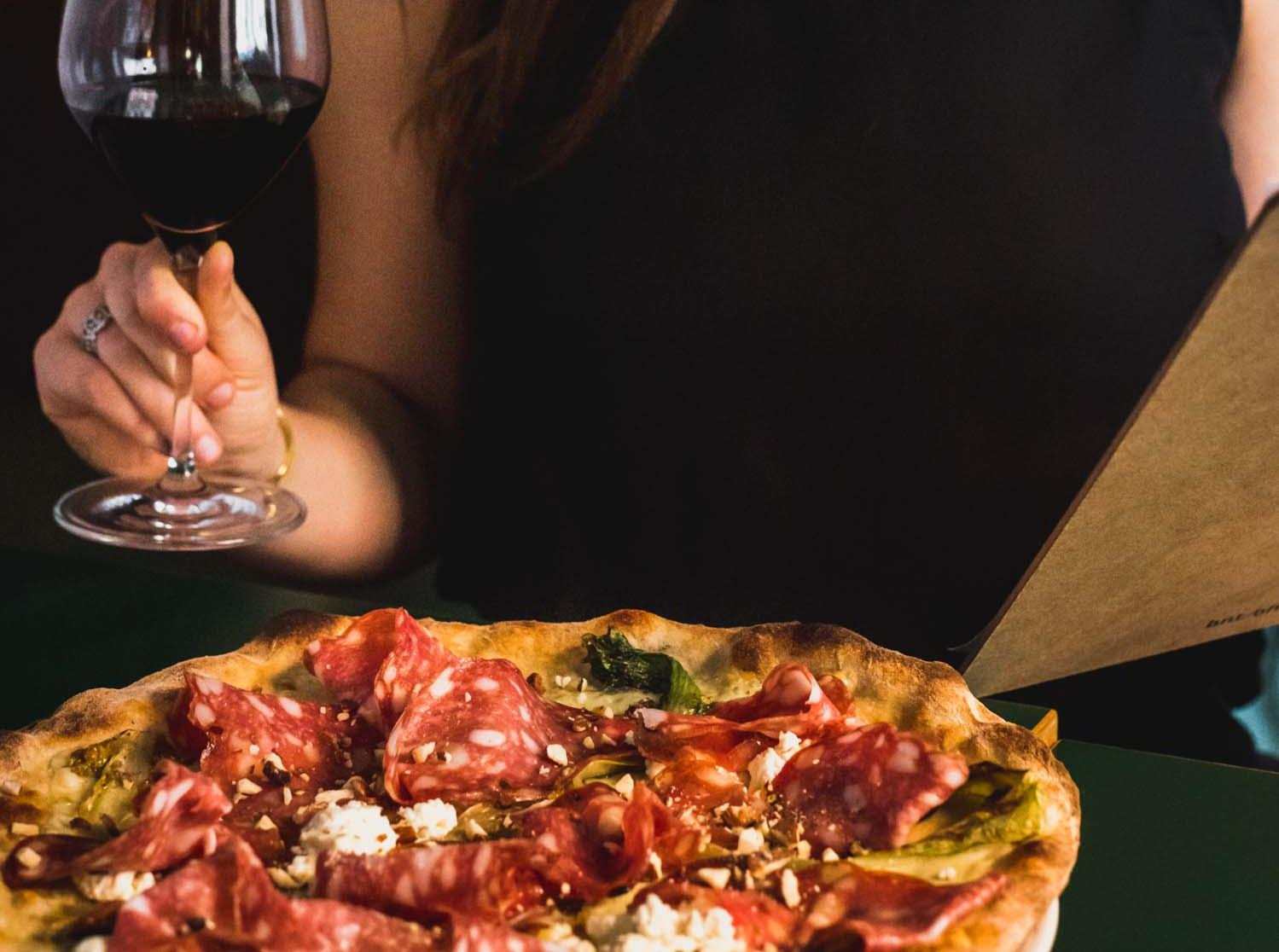Understanding Deep Pan Pizza: The American Innovation
Let’s start with the basics. Deep dish pizza has a signature thick crust that is bread-like, has a thicker volume of toppings, and has a crust that is two or more inches tall. Deep dish pizzas are baked in pans that resemble cake tins.
This isn’t a variation that emerged in Naples or Rome – it’s an American creation, born in Chicago in the 1940s. The first recipe for home cooks appeared as early as 1945, according to Chicago Tribune archives, representing Italian-American innovation adapting Old World traditions to New World tastes.
Picture this: instead of a thin, crispy base topped lightly with sauce and cheese, you have a substantial crust pressed into a deep pan, layered with cheese first, then toppings, and finally sauce on top. Chicago deep-dish pizza rearranges the typical layering of toppings because it is much thicker than regular pizza, so the cheese and other toppings would likely burn if left too exposed. It’s pizza reimagined as architecture.
The Italian Reaction: It’s Complicated
Here’s where things get interesting. Just like the U.S., Italy has different styles of pizza depending on the region. The most famous ones are the Neapolitan (small with a thick crust and soft dough) and the Roman (large, crispy and thin-crusted).
When Italians encounter deep pan pizza, reactions vary from curiosity to confusion. Growing up near Rome, our founders Francesco, Danilo, and Daniel never saw anything resembling Chicago deep dish. Italian pizza philosophy centers on balance and lightness – even the thicker Neapolitan style is designed to be airy and digestible.
Deep pan pizza, to Italian eyes, is more like a savory pie or casserole than what we traditionally call pizza. Deep dish pizza is sometimes more likened to a casserole than a pizza, which isn’t criticism – it’s just recognition that it’s fundamentally different from Italian traditions.
What Makes Deep Pan Different from Italian Pizza
Let’s break down the key differences that set deep pan apart from what we serve at our Vesterbro location:
The Crust Philosophy
Italian pizza, whether Neapolitan or Roman, treats the crust as the foundation that shouldn’t overwhelm. At MaMeMi, our Roman-style base is thin and crispy – you taste the quality of the dough, but it doesn’t dominate the experience.
Deep pan pizza embraces the opposite philosophy: the crust becomes a substantial part of the meal itself. Pan crust is under the thick crust umbrella, with a half-inch thickness, while thin crust is usually around a quarter-inch thick or less.
Topping Abundance
Traditional Italian pizza uses toppings sparingly. Our guanciale pizza, for example, features carefully selected ingredients that complement each other without creating heaviness. A true-to-Italy pizza rarely has more than one topping placed atop the fresh discs of mozzarella cheese and often, no topping at all.
Deep pan pizza, conversely, celebrates abundance. Multiple meats, vegetables, and generous amounts of cheese create a filling, hearty meal that’s meant to satisfy on a different level.
Eating Experience
Roman pizza, like ours at MaMeMi, is designed to be light enough that you can enjoy it with wine, have room for antipasti, and maybe even share multiple pizzas. You leave satisfied but not uncomfortably full. Deep pan is an experience unto itself – often the entire meal, requiring utensils and time to work through its substantial layers.
The Chicago Story: Pizza Meets American Innovation
Deep pan pizza emerged from Italian-American communities in Chicago, where immigrants adapted their traditions to American tastes and ingredients. It represents something genuinely interesting – not trying to be Italian pizza, but creating something new inspired by Italian foundations.
Here’s a surprising fact: according to Grubhub data and the company Chicago Pizza Tours, thin-crust outsells the more widely known deep-dish style among locals, with GrubHub stating that deep-dish comprises only 9% of its pizza deliveries. Even in Chicago, the home of deep dish, locals often prefer thinner styles for everyday eating. Deep dish becomes more of a special occasion or tourist experience.
Italian Thick Crust: Pizza al Tegamino
Interestingly, Italy does have its own version of pan pizza, though quite different from Chicago style. Pizza al tegamino, or pizza al padellino, is very popular in Turin, northwestern Italy. It’s cooked in a cake pan or iron pan, but remains much thinner and lighter than American deep dish. This shows how the same concept – baking pizza in a pan – can produce vastly different results depending on culinary philosophy. The Italian version stays true to principles of lightness and digestibility that define Mediterranean cooking.
Why We Chose Roman Style for Copenhagen
When we opened MaMeMi near Enghave Plads, we could have gone in many directions. We chose Roman style because it aligns with both Italian traditions and Copenhagen’s dining culture.
The Wine Connection
Our natural wine bar concept works beautifully with thin, crispy pizza. The lighter base doesn’t overwhelm wine flavors, allowing our carefully selected collection of over 400 Italian wines to shine. Deep pan pizza, while delicious in its own right, would compete with rather than complement fine wine.
Modern Dining Preferences
Copenhagen diners appreciate quality over quantity, craftsmanship over excess. Our 48-hour fermentation process and carefully sourced ingredients represent an approach that resonates here – thoughtful preparation, excellent materials, balanced results.
Digestibility and Balance
Italian food philosophy emphasizes feeling good after eating. Our Roman-style pizzas, fermented slowly and topped thoughtfully, leave you satisfied but energized. It’s the Mediterranean approach to food – nourishment that enhances life rather than weighing you down.
Respecting Different Pizza Traditions
Here’s something important: saying deep pan pizza isn’t traditionally Italian doesn’t make it less valid. It’s a legitimate regional American style with its own devoted following. Pizza’s story includes both preservation and innovation.
What matters is honesty about what you’re serving and why. At MaMeMi, we’re transparent about our Roman roots and why we make pizza the way we do. Deep dish restaurants should be equally proud of their Chicago heritage.
The Best Pizza is the One You’re in the Mood For
Sometimes you want something light and crispy that pairs with wine and conversation – that’s when you visit us on Vesterbro. Sometimes you want something substantial and filling that becomes the entire meal – that’s when deep dish makes sense.
The beauty of pizza’s evolution is that these choices exist. Italian traditions gave the world a foundation, and different cultures have built upon it in ways that reflect their own values and tastes.
Experience the Roman Difference
If you’ve mainly experienced thick-crust or deep pan pizza and are curious about authentic Italian thin crust, we’d love to introduce you to Roman style. It’s not better or worse – it’s different, offering a completely distinct experience that connects directly to centuries-old Italian traditions. Visit our Vesterbro location near Vega and discover what makes Roman pizza special. You might find that what you’ve been missing isn’t more pizza, but a different philosophy of how pizza should be made and enjoyed.
Our approach isn’t about competing with deep pan – it’s about offering Copenhagen something authentically Roman, made with techniques passed down through generations and adapted thoughtfully for modern dining. Experience authentic Roman-style pizza at MaMeMi on Vesterbro – where tradition meets quality in every thin, crispy bite.























